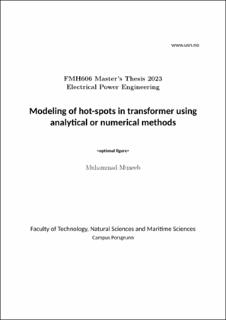| dc.description.abstract | Due to the increasing penetration of renewable energy sources into electrical grids, high variation of power becomes a problem for the stability of power systems. To keep the system balanced, hydro generators occasionally operate in boosting mode during short time intervals, which produces more reactive power than the threshold (Q > 1p.u.). This leads to Transformer and Excitation systems operating at higher ratings which results in thermal stress.
The main goal of this thesis is to analyze the thermal impact on the transformers when operated in boosting mode. Two main approaches are performed in this thesis, simple ana- lytical modeling in Julia and numerical modeling of electromagnetics and thermodynamics in Comsol Multiphysics® of transformers are studied. The model for the 2D-numerical modeling is a 5MVA air-cooled three-phase distribution transformer which is located in Uleberg and owned by Agder Energy. Magnetic flux density in the core, current density, heat loss density, and temperature are discussed in the results. Effects of change in Ambient temperature and cooling conditions are also inspected in the results.
The University of South-Eastern Norway accepts no responsibility for the results and conclusions presented in this report. | |
